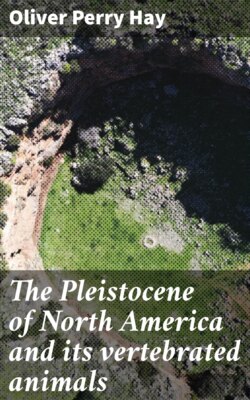Читать книгу The Pleistocene of North America and its vertebrated animals - Oliver Perry Hay - Страница 10
На сайте Литреса книга снята с продажи.
V. Connections with Asia and South America.
ОглавлениеTable of Contents
Mention has just been made of a land connection with Asia at some time about the beginning of the Pleistocene. The evidence for this may be called circumstantial rather than direct. The geological evidence has not been developed. If any deposits containing marine fossils had been laid down along the Asiatic and Alaskan coasts during a time of elevation, they would now be covered by the sea. Our evidence for the connection is derived from the distribution of the vertebrate animals. During the early Pleistocene our country was invaded by a host of mammals whose home was originally in Asia. These included elephants, bisons, elk, goats, bears, wolves, and foxes, besides many mammals of smaller size. It is the presence in America of the smaller animals, many genera of rodents of Asiatic origin, that shows that there must have been a land connection. These could not have made their passage across Bering Strait on the ice, as it might be imagined the larger animals did.
The way between the two continents had more than once before been open, but it was during the early Pleistocene that modern Asiatic genera entered North America in great numbers. Exactly where the land bridge between the two countries was situated is not certain; it may be that a large part of the area now occupied by Bering Sea was then dry land. Arldt (Entwicklung der Kontinente, plate 21) represents a connection extending from the northern border of Alaska southward to include the Aleutian Islands. Where narrowest, this bridge, as represented by the author named, extended from latitude 60° to 70°, a distance of about 700 miles. In such case the cold currents from the Arctic Ocean would have been prevented from entering the Pacific, while the Japan Current would have warmed up the southern side of the bridge. The route was then open on the north for the boreal animals of Asia to enter Alaska; while on the south the genera inhabiting the more temperate part of eastern Asia would have had free access to the American shore. Once on the continent, the boreal mammals might have spread along the shores of the Arctic Ocean and those of the temperate parts of Asia have made their way up the Yukon Valley, or possibly along the Pacific coast, to the warmer regions toward the south. We do not need to suppose that even during the first glacial, or Nebraskan, stage the climate of that part of North America was as inclement as now.
At the other end of our continent a train of events not wholly dissimilar was in motion. Even in the latter part of the Pliocene some South American edentates, such as Megalonyx, Mylodon, and Glyptotherium, had reached Texas. Probably a little later the bridge had become widened so that other edentates and a few genera of South American hystricine rodents swarmed into our southern borders. At the same time a host of carnivores, tapirs, horses, camels, peccaries, deer, and cricetine and sciurine rodents made their way into South America. It is now certain that the land bridge over which the interchange took place did not include the West Indies. Possibly there yet remained along the western coast of Central America some of the border, now submerged, which Schuchert (Bull. Geol. Soc. Amer., vol. XX, plates 96 to 100) represents as being present during the Tertiary.
